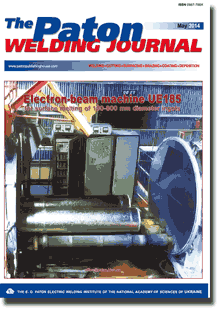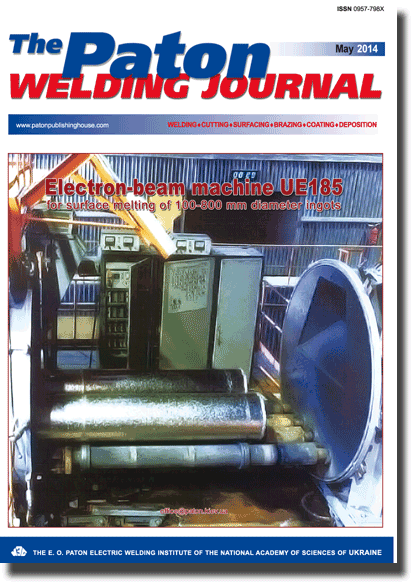Access for download PDF files for subscribers and for reviewers of scientometric bases.
Organization: Elsevier for content access(PDF files of journals released before 2024 are available for download from the website's archives))
Organization: Elsevier for content access(PDF files of journals released before 2024 are available for download from the website's archives))
| 2014 №05 (01) |
DOI of Article 10.15407/tpwj2014.05.02 |
2014 №05 (03) |

The Paton Welding Journal, 2014, #5, 16-20 pages
FEATURES OF MELTING, STRUCTURE AND PROPERTIES OF NI—MN—CU SYSTEM NICKEL ALLOYS
Khorunov V.F. and Lototsky P.N.
E.O. Paton Electric Welding Institute, NASU. 11 Bozhenko Str., 03680, Kiev, Ukraine. E-mail: office@paton.kiev.ua
Abstract
Influence of nickel alloy composition and method of melting on their structure and properties were studies. Melting was performed in argon and under a layer of flux. It is established that argon-arc melting of nickel alloys with high manganese content allows producing ingots of a more stable composition than in submerged- arc melting. It is noted that alloys of the considered system are prone to porosity. Increase of pouring temperature promotes reduction of porosity in ingots. Structure of ingots with different manganese content in as-cast condition, after annealing and rolling was studied. It was shown that at manganese content in the alloys of up to 25 wt.%, it is possible to produce ingots of a higher strength and ductility, which lend themselves easily to forming. After rolling the alloys have the structure of fine-grained solid solution. Strength of such a metal reaches 900—950 MPa at relative elongation of about 40 %. At greater manganese content the alloys become brittle as a result of formation of intermetallic phases in them. 8 Ref., 3 Tables, 7 Figures.
Keywords: Ni—Mn—Cu system alloys, submergedarc and inert-gas arc melting, structure, mechanical properties of alloys, brazing, braze alloy
Received: 14.01.14
Published: 28.05.14
References
1. Salli, A. (1959) Manganese. Moscow: Metallurgizdat.
2. Bochvar, N.R., Guzej, L.S., Lysova, E.V. et al. (1979) Binary and multicomponent systems on copper base. Moscow: Nauka.
3. Chjan-Bao-Chan (1958) Examination of ternary alloys Cu—Mn—Ni. Izvestiya Vuzov. Tsvet. Metallurgiya, 5, 107—115.
4. Bazhenov, V.E. (2013) Study of crystallization processes of ternary alloys for the purpose of evaluation of their susceptibility to nonequilibrium crystallization: Syn. of Thesis for Cand. of Techn. Sci. Degree.
5. (2003) Reference book on soldering. Ed. by I.E. Petrunin. 3rd ed. Moscow: Mashinostroenie.
6. Lashko, S.V., Lashko, N.F. (1988) Brazing of metals. Moscow: Mashinostroenie.
7. Khorunov, V.F. (2008) Principles of brazing thinwalled high-alloy steel structures. Kiev: Naukova Dumka.
8. Khorunov, V.F., Doroshenko, L.K., Vasiliev, V.G. (1988) Diagram of meltability and structure of alloys of nickel-manganese-copper-silicon
Suggested Citation
Khorunov V.F. and Lototsky P.N. (2014) FEATURES OF MELTING, STRUCTURE AND PROPERTIES OF NI—MN—CU SYSTEM NICKEL ALLOYS. The Paton Welding J., 05, 10-15.The cost of subscription/purchase order journals or individual articles
| Journal/Currency | Annual Set | 1 issue printed |
1 issue |
one article |
| TPWJ/USD | 384 $ | 32 $ | 26 $ | 13 $ |
| TPWJ/EUR | 348 € | 29 € | 24 € | 12 € |
| TPWJ/UAH | 7200 UAH | 600 UAH | 600 UAH | 280 UAH |
| AS/UAH | 1800 UAH | 300 UAH | 300 UAH | 150 UAH |
| AS/USD | 192 $ | 32 $ | 26 $ | 13 $ |
| AS/EUR | 180 € | 30 € | 25 € | 12 € |
| SEM/UAH | 1200 UAH | 300 UAH | 300 UAH | 150 UAH |
| SEM/USD | 128 $ | 32 $ | 26 $ | 13 $ |
| SEM/EUR | 120 € | 30 € | 25 € | 12 € |
| TDNK/UAH | 1200 UAH | 300 UAH | 300 UAH | 150 UAH |
| TDNK/USD | 128 $ | 32 $ | 26 $ | 13 $ |
| TDNK/EUR | 120 € | 30 € | 25 € | 15 € |
AS = «Automatic Welding» - 6 issues per year;
TPWJ = «PATON WELDING JOURNAL» - 12 issues per year;
SEM = «Electrometallurgy Today» - 4 issues per year;
TDNK = «Technical Diagnostics and Non-Destructive Testing» - 4 issues per year.


